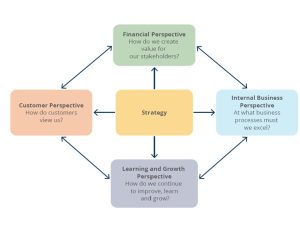10.6 Describe the balanced scorecard and its key dimensions
Rina Dhillon
Balanced Scorecard
A balanced scorecard (hereafter BSC) is a strategic planning framework that businesses use to assign priority to their products, projects, and services; communicate about their targets or goals; and plan their day to day operational activities. The BSC enables businesses to monitor and measure the success of their strategies to determine how well they have performed. The BSC uses a set of financial and non-financial measures that relate to the overall strategy of the business. By integrating financial and non-financial performance measures, the BSC helps to keep management focused on all of a company’s critical success factors, not just its financial ones. One of the key benefit of the BSC is that short-term operating results stay in line with long-term strategic focus. This is done via four key perspectives – financial, internal business, learning and growth and customer – as depicted in the BSC and discussed in detail below:

1. Financial perspective
Under the financial perspective, the goal of a business is to ensure that it earns a return on the investments made and manages key risks involved in running the business. The goals can be achieved by satisfying the needs of all stakeholders involved within the business, such as shareholders, customers, and suppliers, by asking the question “How do we create value for our stakeholders”? The shareholders are an integral part of the business since they are the providers of capital; they should be happy when the business achieves financial success. They want to be sure that the business is continually generating revenues and that the business meets goals such as improving profitability and developing new revenue sources. Steps taken to achieve such goals may include introducing new products and services, and cutting down on the costs of doing business.
2. Internal business processes perspective
A business’ internal processes determine how well the organisation runs by asking the question “How do we continue to improve, learn and grow”?. A BSC puts into perspective the measures and objectives that can help the business run more effectively. Also, the scorecard helps evaluate the business’ products or services and determine whether they conform to the standards that customers desire. A key part of this perspective is aiming to answer the question, “At what business processes must we excel?” The answer to that question can help the business formulate marketing strategies and pursue innovations that lead to the creation of new and improved ways of meeting the needs of customers.
3. Learning and growth perspective
Learning and growth is important in optimising goals and objectives to achieve favourable results. Managers and employees are required to demonstrate high performance in terms of leadership, the business’ culture, application of knowledge, and skill sets. Proper infrastructure of learning and growth is required to support and allow the objectives of the other three perspectives within the BSC. If learning improves, internal business processes will improve, leading to increased customer value and satisfaction and ultimately to better financial performance.
4. Customer perspective
The customer perspective monitors how the business is providing value to its customers and determines the level of customer satisfaction with the business’ products and services. Customer satisfaction is an indicator of the business success. How well a company treats its customers can obviously affect its profitability. The BSC considers the business’ reputation versus its competitors, with a key question being “How do customers view us vis-à-vis our competitors? It enables the business to step out of its comfort zone to view itself from the customer’s point of view rather than just from an internal perspective. Some of the strategies that a company can focus on to improve its reputation among customers include improving product quality, enhancing the customer shopping experience, and adjusting the prices of its main products and services to make it more competitive.
In summary, the ultimate goal of the BSC is to use a set of financial and non-financial performance measures that relate to the overall strategy of the business.